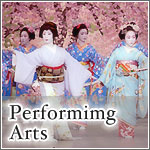***
Она утешена вишнёвой сладостью…
Под тенью крон сакуры и сосны…
Глаза её полны спокойной радости,
Морозной свежести и нежности весны…
Её уста пропитаны заботой…
Она – шептание в садах Киото…
***
Ты никогда не звал её по имени…
Вдыхая сонный аромат густых волос,
Губами обнажал святые линии…
Ей предан ты…
В неё влюблён до слёз…
***
Не променяешь ни на что её красоты,
Как вкус вишнёвый той мечты в Киото…
©_Dreamer4u_
Together with the willow and mountain laurel, the Takao maple tree is the Kyoto city tree and is loved by the citizens. Its rich colors add to the beauty of Kyoto's autumn.
The bright autumnal tints of Kyoto's foliage captivated the hearts of ancient Japanese people and have been used often as motifs in literature and art. Enjoying the fall colors is as important a traditional past time as viewing the cherry blossoms in the spring. The maple trees most common to Japan are called Takao maple, or Iroha maple. Takao, the place after which the tree is named, is one of the three famous spots in the foothills of Kyoto's northwestern mountains (together with Makino-o and Togano-o). It was well known from ancient times for its fall colors, and the scene of people viewing leaves is depicted in the folding screens, Viewing Maple Trees in Takao, designated National Treasure (attrib. to Kano Hideyori, Momoyama Period).
Kyoto is one of Japan's leading large cities, founded upon the Heian Capital, which was built in 794 AD. Its population of 1.47 million citizens lives in harmony with a natural and cultural environment which has developed over time immemorial. Kyoto City is a place where you can truly savor first-hand a rich depth of culture and art steeped in tradition, and set against the changing backdrop of the four seasons, with each one possessing its own charm.




On the other hand, although Kyoto has inherited a superb history of tradition and culture established over countless generations, it is also constantly creating new forms of culture and industry with its progressive and revolutionary spirit.




With this kind of Kyoto in mind, I am working towards bringing out the best our city has to offer, building upon a philosophy of trust and partnership with the citizens, in order to create a city which possesses both ease and vibrancy, fully-equipped to handle the demands of the modern world. In these changing times, we are faced with the fast-progressing concerns of the declining birth rate and an aging society, along with serious global-scale environmental problems. However, now and in the future, I will strive to ensure the peace of mind and safety of Kyoto's citizens, and aim to have Kyoto's reputation as a truly vibrant city well-recognized, and its existence appreciated, throughout Japan and the world.






